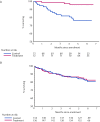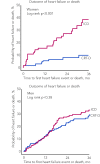Sex Differences in Utilisation and Response to Implantable Device Therapy
- PMID: 26835114
- PMCID: PMC4711527
- DOI: 10.15420/aer.2015.04.02.129
Sex Differences in Utilisation and Response to Implantable Device Therapy
Abstract
Multiple studies have demonstrated that implantable cardioverter-defibrillators (ICDs) and cardiac resynchronisation therapy (CRT) provide significant mortality and morbidity benefits to eligible patients irrespective of gender. However, female patients are less likely to receive this life-saving therapy and are significantly under-represented in cardiac device trials. Various performance improvement programmes have proved that this gender disparity can be reduced and these therapies should be offered to all eligible patients regardless of sex. Efforts should be made to enrol more women in clinical trials and sex-specific analysis in medical device clinical studies should be encouraged. In this article we review the data on sex differences in clinical outcomes with ICDs and CRT and explore the reasons for this sex-based disparity.
Keywords: Implantable cardioverter-defibrillator; cardiac resynchronisation therapy; gender differences in cardiac device utilisation; sudden cardiac death.
Figures




Similar articles
-
Sex-based differences in cardiac resynchronization therapy and implantable cardioverter defibrillator therapies: effectiveness and use.Cardiol Rev. 2006 Nov-Dec;14(6):292-8. doi: 10.1097/01.crd.0000244462.33052.72. Cardiol Rev. 2006. PMID: 17053376 Review.
-
Overview of implantable cardioverter defibrillator and cardiac resynchronisation therapy in heart failure management.Singapore Med J. 2016 Jul;57(7):354-9. doi: 10.11622/smedj.2016117. Singapore Med J. 2016. PMID: 27440409 Free PMC article. Review.
-
Clinical effectiveness of cardiac resynchronization and implantable cardioverter-defibrillator therapy in men and women with heart failure: findings from IMPROVE HF.Circ Heart Fail. 2014 Jan;7(1):146-53. doi: 10.1161/CIRCHEARTFAILURE.113.000789. Epub 2013 Oct 31. Circ Heart Fail. 2014. PMID: 24178311
-
Effectiveness of implantable cardioverter-defibrillators for the primary prevention of sudden cardiac death in women with advanced heart failure: a meta-analysis of randomized controlled trials.Arch Intern Med. 2009 Sep 14;169(16):1500-6. doi: 10.1001/archinternmed.2009.255. Arch Intern Med. 2009. PMID: 19752408
-
Differences in mode of death between men and women receiving implantable cardioverter-defibrillators or cardiac resynchronization therapy in the MADIT trials.Heart Rhythm. 2023 Jan;20(1):39-45. doi: 10.1016/j.hrthm.2022.08.018. Epub 2022 Aug 22. Heart Rhythm. 2023. PMID: 36007729
Cited by
-
Sex-Specific Differences in Ventricular Remodeling and Response After Cardiac Resynchronization Therapy.Am J Cardiol. 2022 Jul 1;174:68-75. doi: 10.1016/j.amjcard.2022.03.021. Epub 2022 Apr 23. Am J Cardiol. 2022. PMID: 35473782 Free PMC article.
-
Association of sex, age and education level with patient reported outcomes in atrial fibrillation.BMC Cardiovasc Disord. 2019 Apr 5;19(1):85. doi: 10.1186/s12872-019-1059-6. BMC Cardiovasc Disord. 2019. PMID: 30953478 Free PMC article.
-
Sex, Race, and Age Differences in Cardiovascular Outcomes in Implantable Cardioverter-Defibrillator Randomized Controlled Trials: A Systematic Review and Meta-analysis.CJC Open. 2021 Sep 24;3(12 Suppl):S209-S217. doi: 10.1016/j.cjco.2021.09.015. eCollection 2021 Dec. CJC Open. 2021. PMID: 34993451 Free PMC article. Review.
-
Inequality between women and men in ICD implantation.Int J Cardiol Heart Vasc. 2022 Jun 25;41:101075. doi: 10.1016/j.ijcha.2022.101075. eCollection 2022 Aug. Int J Cardiol Heart Vasc. 2022. PMID: 35782706 Free PMC article.
-
Gender medicine: effects of sex and gender on cardiovascular disease manifestation and outcomes.Nat Rev Cardiol. 2023 Apr;20(4):236-247. doi: 10.1038/s41569-022-00797-4. Epub 2022 Oct 31. Nat Rev Cardiol. 2023. PMID: 36316574 Free PMC article. Review.
References
-
- Mozaffarian D, Benjamin EJ, Go AS et al. Heart disease and stroke statistics–2015 update: a report from the American Heart Association. Circulation. 2015;131:434–41. - PubMed
-
- Moss AJ, Hall WJ, Cannom DS et al. Improved survival with an implanted defibrillator in patients with coronary disease at high risk for ventricular arrhythmia. N Engl J Med. 1996;335:1933–40. - PubMed
-
- Buxton AE, Lee KL, Fisher JD et al. A randomized study of the prevention of sudden death in patients with coronary artery disease. Multicenter UnSustained Tachycardia Trial Investigators. N Engl J Med. 1999;341:1882–90. - PubMed
-
- Moss AJ, Zareba W, Hall WJ et al. Prophylactic implantation of a defibrillator in patients with myocardial infarction and reduced ejection fraction. N Engl J Med. 2002;346:877–83. - PubMed
-
- Bardy GH, Lee KL, Mark DB et al. for the Sudden Cardiac Death in Heart Failure Trial (SCD-HeFT) Investigators. Amiodarone or an implantable cardioverter-defibrillator for congestive heart failure. N Engl J Med. 2005;352:225–37. - PubMed
LinkOut - more resources
Full Text Sources
Other Literature Sources
Research Materials

